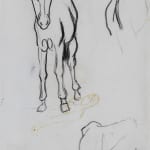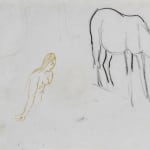Paul GAUGUIN
Provenance
Rodolphe Hecht, Haifa (c. February 1974);
Private collection;
Sotheby's London, October 23, 1985, no. 20;
Private collection, Italy.
Pubblicazioni
Animalia, Galleria Paolo Antonacci Rome, May 2023, entry n. 12.
The French painter Eugène Henri Paul Gauguin is considered one of the greatest of the Post-Impressionists.
After a turbulent and profligate youth, Gauguin married a Danish girl named Mette Gad in 1873 and the couple had fully five children. Yet the passion growing in him was a passion for the arts. He soon began to invest his money in contemporary painting, collecting the work of Cézanne, Pissarro, Sisley, Monet and others. With the encouragement of Pissarro and Degas, he agreed to show his own work at exhibitions of Impressionist art, starting in 1879.
The financial collapse of the Union Générale in 1883 forced the firm for which Gauguin was working to make stringent staff cuts and the artist lost his job. From that moment on, he devoted his energies solely to painting.
He showed his work at the eighth and final Impressionist exhibition in May 1886.
Travelling to Panama in 1887, he fell in love with the place, identifying it as the earthly paradise he so hankered after, but he was beset by financial difficulties and had to return to Paris in November of that year.
Discouraged, he left for Pont-Aven in February 1888. Vincent van Gogh, who was also in Paris, decided to leave the capital and move to Arles in that same year. Gauguin agreed to go and live with Vincent in Arles thanks, among other things, to encouragement from Théo, but their time in Arles was to prove difficult for both artists.
ISCRIVITI ALLA NOSTRA MAILING LIST
Subscribe to our mailing list in order to receive news on new acquisitions, exhibitions, special previews and more!
* denotes required fields
We will process the personal data you have supplied to communicate with you in accordance with our Privacy Policy. Puoi annullare l'iscrizione o modificare le tue preferenze in qualsiasi momento facendo clic sul collegamento nelle nostre e-mail modificare.



